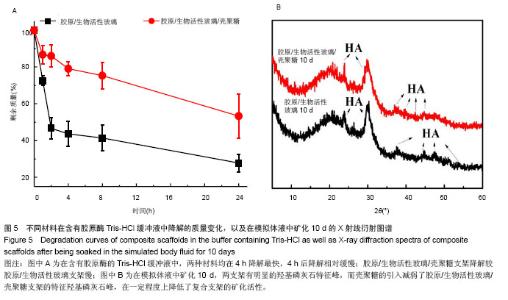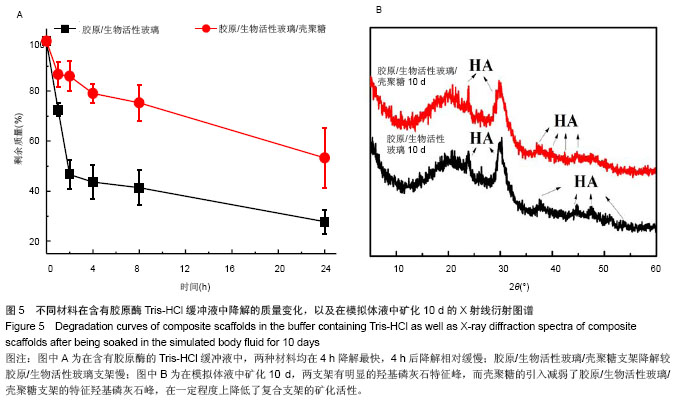Chinese Journal of Tissue Engineering Research ›› 2014, Vol. 18 ›› Issue (21): 3367-3373.doi: 10.3969/j.issn.2095-4344.2014.21.016
Previous Articles Next Articles
Collagen/bioactive glass/chitosan composite scaffolds
Meng Yong-chun1, Chen Xiao-feng 1, 2 , Nan Kai-hui1, Li Yu-li2, Luo Xiao-gang1, Deng Chun-lin2
- 1 Wenzhou Engineering Research Center for Biomaterials, the Eye Hospital of Wenzhou Medical University, Wenzhou 325027, Zhejiang Province, China; 2 National Engineering Research Center for Tissue Restoration and Reconstruction, School of Materials Science and Engineering, South China University of Technology, Guangzhou 510640, Guangdong Province, China
-
Online:2014-05-21Published:2014-05-21 -
Contact:Deng Chun-lin, National Engineering Research Center for Tissue Restoration and Reconstruction, School of Materials Science and Engineering, South China University of Technology, Guangzhou 510640, Guangdong Province, China -
About author:Meng Yong-chun, Wenzhou Engineering Research Center for Biomaterials, the Eye Hospital of Wenzhou Medical University, Wenzhou 325027, Zhejiang Province, China -
Supported by:the Natural Science Foundation of Zhejiang Province, No. Y407241; the National Natural Science Foundation of China, No. 51072055, 50830101; the Major State Basic Research Development Program of China (973 Program), No. 2011CB606204
CLC Number:
Cite this article
Meng Yong-chun, Chen Xiao-feng, Nan Kai-hui, Li Yu-li, Luo Xiao-gang, Deng Chun-lin. Collagen/bioactive glass/chitosan composite scaffolds[J]. Chinese Journal of Tissue Engineering Research, 2014, 18(21): 3367-3373.
share this article
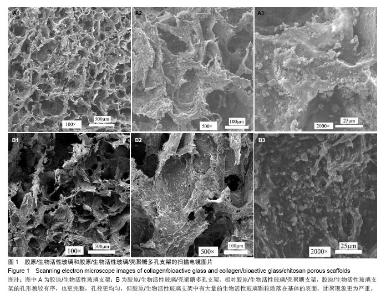
2.1 孔支架的形貌分析 图1为胶原/生物活性玻璃、胶原/生物活性玻璃/壳聚糖支架的横截面形貌扫描电镜图片,以及生物活性玻璃颗粒的分散形貌图。 从图中对比可以发现,相对胶原/生物活性玻璃/壳聚糖支架,胶原/生物活性玻璃支架的孔形貌较有序,也更完整,孔径更均匀,但胶原/生物活性玻璃支架中有大量的生物活性玻璃颗粒散落在基体的表面,团聚现象更为严重,导致这种现象可能的原因主要有:在酸性条件下,壳聚糖分子表面带大量的正电荷,而生物活性玻璃颗粒表面带负电荷,壳聚糖作为分散剂不仅可以通过物理作用将生物活性玻璃颗粒隔离开,同时可通过电荷吸引将生物活性玻璃颗粒吸附在壳聚糖胶体上,阻碍生物活性玻璃颗粒的沉降,因而胶原/生物活性玻璃/壳聚糖支架中生物活性玻璃颗粒分散较均匀;壳聚糖和胶原分子间分子尺度的混合,使生物活性玻璃颗粒更易均匀的分散于胶原分子形成的胶原纤维中。这与Zhang等[16]研究的壳聚糖能促进羟基磷灰石颗粒在胶原溶液中的分散结果相一致。"
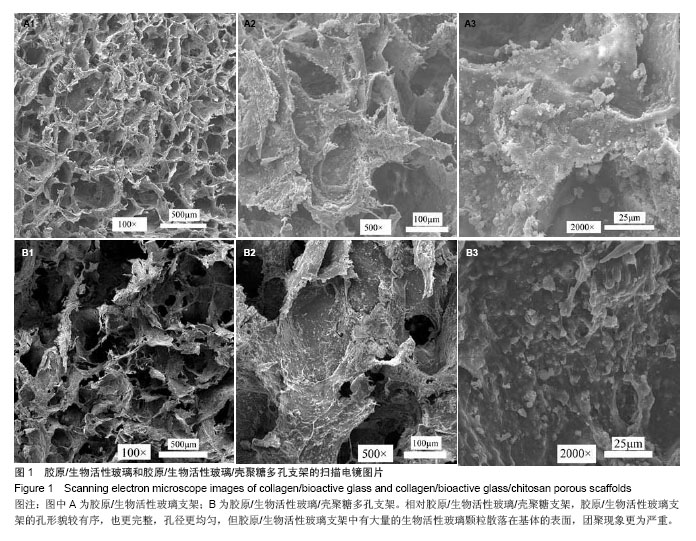
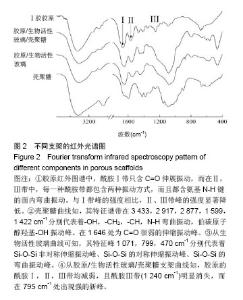
2.2 复合支架材料分子间的相互作用分析 图2为支架中不同组分的红外图谱。 由胶原红外图谱中,胶原蛋白的酰胺A谱带(3 325- 3 330 cm-1)主要是由N-H的伸缩振动引起的,酰胺A谱带对胶原蛋白三螺旋结构很敏感;酰胺Ⅰ谱带(1 650 cm-1)通常不受肽链侧基影响,振动频率取决于肽链构型,由蛋白多肽骨架的C=O伸缩振动引起的,为蛋白质的二级结构变化的敏感区域,且其吸收最强,常被用于蛋白质的二级结构分析,同时对三螺旋结构的变化也非常敏感[21];酰胺Ⅱ谱带(1 554 cm-1)主要反映胶原蛋白的C-N(具有双键性质)伸缩振动和面内N-H弯曲振动,同时也是α-螺旋、β-折叠、转角和无规卷曲叠加的吸收带。与酰胺Ⅰ谱带相同,酰胺Ⅱ谱带也不易受肽链侧基影响,但对胶原蛋白的三螺旋结构不敏感[22];酰胺Ⅲ谱(1 240 cm-1)带主要由同相N-H弯曲振动和C-N伸缩振动共同引起的,此外还含些许C-O面内弯曲振动和C-C伸缩振动。此谱带的振动组成比较复杂,侧链结构对其有不同程度的影响,但此谱带仍可用于蛋白质二级结构预测[23]。酰胺Ⅰ带只含C=O伸展振动,而在Ⅱ,Ⅲ带中,每一种酰胺带都包含两种振动方式,而且都含氨基N-H键的面内弯曲振动。与Ⅰ带峰的强度相比,Ⅱ、Ⅲ带峰的强度显著降低,表明N-H键面内弯曲振动受阻的程度远大于C=O键的伸展振动。从壳聚糖曲线知,其特征谱带在3 433,2 917,2 877,1 599,1 422 cm-1分别代表着-OH,-CH2,-CH,N-H弯曲振动,伯碳原子醇羟基-OH振动峰。在1 646处为C=O很弱的伸缩振动峰,表明壳聚糖的脱乙酰化程度很高(≥92%)[24]。从生物活性玻璃曲线可知,其特征峰1 071,799,470 cm-1分别代表着Si-O-Si非对称伸缩振动峰、Si-O-Si的对称伸缩振动峰、Si-O-Si的弯曲振动峰[25-26]。"
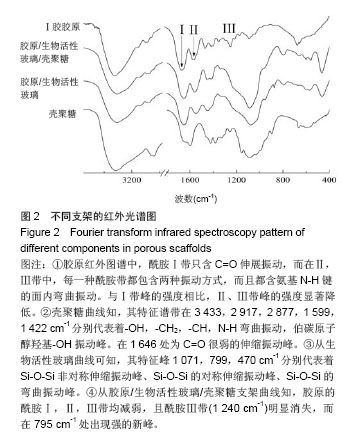
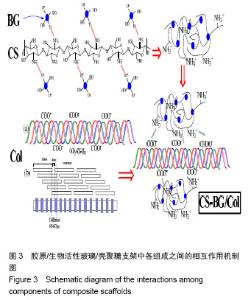
从胶原/生物活性玻璃/壳聚糖支架曲线知,胶原的酰胺Ⅰ,Ⅱ,Ⅲ带均减弱,且酰胺Ⅲ带(1 240 cm-1)明显消失,而在795 cm-1处出现强的新峰。生物活性玻璃与胶原复合后在795 cm-1出现新的吸收峰,其为Si-C的伸缩振动峰,由生物活性玻璃表面的Si-OH基团与胶原中的-C=N-基团发生了化学键合反应[27],同时生物活性玻璃中的钙离子与胶原中游离的羧基螯合,导致胶原上酰胺谱带振动的减弱[28-29]。据Sionkowska等[30]研究显示在生物活性玻璃复合材料中,壳聚糖含量的增加会导致胶原的Ⅲ带的逐渐减弱,至胶原组分低于30%时,酰胺Ⅲ带被完全包裹,峰信号被弱化,特征峰消失,均说明高分子相之间发生了明显的分子尺度的相互作用,分子间的相互作用示意图见图3。"
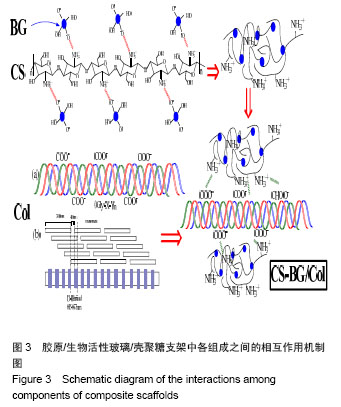
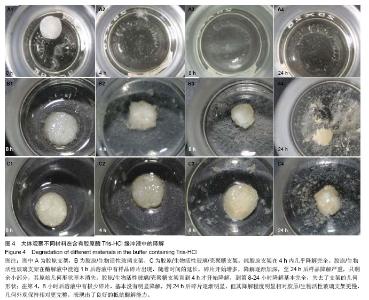
2.3 支架的力学性能分析 干态下复合支架的抗压强度采用SPSS 17.0作统计学分析(n=5)。纯胶原支架、胶原/生物活性玻璃支架、胶原/生物活性玻璃/壳聚糖支架的抗压强度分别为0.08,1.56,2.34 MPa,后两者力学性能均有显著性提高。壳聚糖引入材料中后,一方面使生物活性玻璃颗粒更容易进入胶原纤维的空隙之中,促进了生物活性玻璃颗粒在基体中的分散,减少了因为生物活性玻璃颗粒分散不均匀导致的力学性能差的缺点;另一方面,壳聚糖引入后,因为其带大量的自由-OH、-NH2基团,有利于分子之间氢键生成,提高了分子间的相互作用力。 2.4 支架的抗酶解性能分析 见图4。 纯胶原支架在4 h内几乎降解完全。胶原/生物活性玻璃支架在酶解液中浸泡1 h后溶液中有样品的碎片出现,随着时间的延长,碎片开始增多,降解逐渐加深,至24 h后,样品降解严重,只剩余小部分,其原始几何形状基本消失。而胶原/生物活性玻璃/壳聚糖支架直到4 h才开始降解,到第8-24小时降解基本完全,失去了支架的几何形状;在第4,8小时后,溶液中有极少碎片,基本没有明显降解,到24 h后碎片逐渐明显,但其降解程度明显相对胶原/生物活性玻璃支架更慢,其几何外观保持相对更完整,表现出了良好的抵抗酶解的能力。"
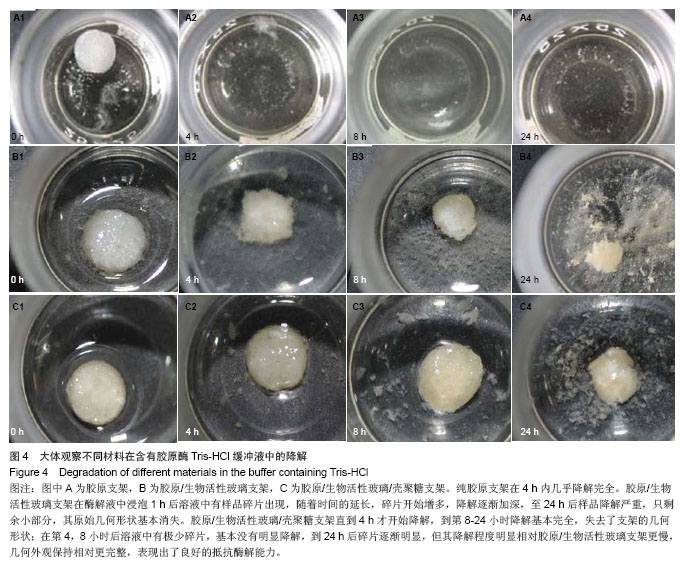
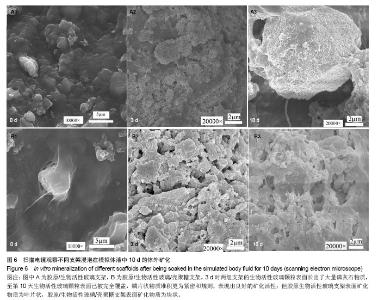
2.5 复合材料的体外矿化活性分析 图6为两种支架矿化不同时间的形貌分析,到第3天,支架表面的生物活性玻璃颗粒表面长出了大量磷灰石物质;至第10天,生物活性玻璃颗粒表面已被完全覆盖,鳞片状物质堆积更为紧密和规则,表现出良好的矿化活性,这与孟永春[32]的研究结果一致。然而,胶原/生物活性玻璃支架表面矿化物质为叶片状,而胶 原/生物活性玻璃/壳聚糖支架表面矿化物质为块状,这可能是壳聚糖作为有机基质与生物活性玻璃,胶原等之间的静电作用和分子间的相互作用,而参与调控生物矿化的结果。 图5B为两种支架矿化10 d后的X射线衍射分析曲线。由图知,矿化到第10天,两样品有明显的羟基磷灰石特征峰[33]:25.9°,31.8°,39.6°,42.1°,46.8°。而壳聚糖的引入,减弱了胶原/生物活性玻璃/壳聚糖支架矿化后的特征羟基磷灰石峰,在一定程度上降低了复合支架的矿化活性,然而这与Zhang等[16]研究壳聚糖促进羟基磷灰石在胶原中分散,以及提高复合支架细胞学活性的结果不一致。"
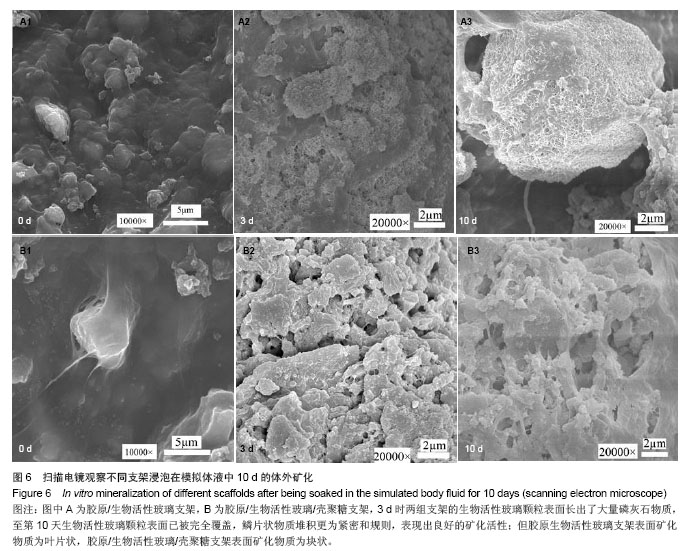
| [1]Kushitani S,Yasukawa E,Iwaki H,et al.Particulate bioglass compared with hydroxyapatite as a bone graft substitute.Clin Orthop Relat Res. 1997;(334):316-325.
[2]Hutmacher DW. Scaffolds in tissue engineering bone and cartilage. Biomaterials. 2000;21:2529-2543.
[3]Li HY,Du RL,Chang J.Fabrication,characterization, and in vitro degradation of composite scaffolds based on PHBV and bioactive glass.J Biomater Appl. 2005;20:137-155.
[4]Shalumon KT,Sowmya S,Sathish D,et al.Effect of Incorporation of Nanoscale Bioactive Glass and Hydroxyapatite in PCL/Chitosan Nanofibers for Bone and Periodontal Tissue Engineering.J Biomed Nanotechnol. 2013; 9:430-440.
[5]Tamjid E,Bagheri R,Vossoughi M,et al.Effect of particle size on the in vitro bioactivity, hydrophilicity and mechanical properties of bioactive glass-reinforced polycaprolactone composites.Mat Sci Eng C-Mater.2011;31:1526-1533.
[6]Alm JJ,Frantzen JPA,Moritz N,et al.In vivo testing of a biodegradable woven fabric made of bioactive glass fibers and PLGA(80)-A pilot study in the rabbit.J Biomed Mater Res B.2010;93B:573-580.
[7]Orava E,Korventausta J,Rosenberg M,et al.In vitro degradation of porous poly(DL-lactide-co-glycolide) (PLGA)/bioactive glass composite foams with a polar structure. Polym Degrad Stabil.2007;92:14-23.
[8]Yang CR,Wang YJ,Chen XF.Mineralization regulation and biological influence of bioactive glass-collagen- phosphatidylserine composite scaffolds.Sci China Life Sci. 2012;55:236-240.
[9]Han X,Chen XF,Meng YC,et al.Biocompatibility of the Composite Scaffold of Sol-Gel Bioactive Glass/Collagen.J Inorg Mater.2011;26:869-873.
[10]Leu A,Leach JK.Proangiogenic potential of a collagen/bioactive glass substrate. Pharm Res.2008;25:1222-1229.
[11]Luz GM,Mano JF.Chitosan/bioactive glass nanoparticles composites for biomedical applications.Biomed Mater. 2012; 7:054104.
[12]Couto DS,Hong ZK,Mano JF.Development of bioactive and biodegradable chitosan-based injectable systems containing bioactive glass nanoparticles.Acta Biomater.2009;5:115-123.
[13]Bhowmik R,Katti KS,Katti DR.Mechanics of molecular collagen is influenced by hydroxyapatite in natural bone.J Mater Sci.2007;42:8795-8803.
[14]Verschueren DS,Gassner R,Mitchell R,et al.The effects of guided tissue regeneration (GTR) on modified Le Fort I osteotomy healing in rabbits.Int J Oral Max Surg.2005;34: 650-655.
[15]Yunoki S,Ikoma T,Tanaka J.Development of collagen condensation method to improve mechanical strength of tissue engineering scaffolds.Mater Charact.2010;61:907-911.
[16]Zhang LH,Tang PF,Zhang W,et al.Effect of Chitosan as a Dispersant on Collagen-Hydroxyapatite Composite Matrices. Tissue Eng Part C-Me.2010;16:71-79.
[17]Richert L,Lavalle P,Payan E,et al.Layer by layer buildup of polysaccharide films: physical chemistry and cellular adhesion aspects.Langmuir.2003;20:448-458.
[18]Yin YJ,Yao KD,Cheng GX,et al.Properties of polyelectrolyte complex films of chitosan and gelatin.Polym Int.1999;48: 429-432.
[19]Chen XF,Meng YC,Li YL,et al.Investigation on bio-mineralization of melt and sol-gel derived bioactive glasses. Appl Surf Sci.2008;255:562-564.
[20]Nam K,Kimura T,Kishida A.Preparation and characterization of cross-linked collagen-phospholipid polymer hybrid gels. Biomaterials.2007;28:1-8.
[21]Payne KJ,Veis A.Fourier transform ir spectroscopy of collagen and gelatin solutions: Deconvolution of the amide I band for conformational studies. Biopolymers. 1988; 27: 1749-1760.
[22]Doyle BB,Bendit EG,Blout ER.Infrared spectroscopy of collagen and collagen-like polypeptides.Biopolymers. 1975; 14:937-957.
[23]Barth A.Infrared spectroscopy of proteins.Biochimica et Biophysica Acta. 2007;1767:1073-101.
[24]Shanmugasundaram N,Ravichandran P,Reddy PN,et al.Collagen-chitosan polymeric scaffolds for the in vitro culture of human epidermoid carcinoma cells. Biomaterials. 2001;22:1943-1951.
[25]Costa HS,Rocha MF,Andrade GI,et al.Sol-gel derived composite from bioactive glass-polyvinyl alcohol.J Mater Sci.2008;43:494-502.
[26]Mansur HS,Oréfice RL,Mansur AAP.Characterization of poly(vinyl alcohol)/poly(ethylene glycol) hydrogels and PVA-derived hybrids by small-angle X-ray scattering and FTIR spectroscopy.Polymer.2004;45:7193-7202.
[27]Kida T,Nagasaka Y,Sakurai T, et al.Growth and Characterization of SiC Films by Hot-Wire Chemical Vapor Deposition at Low Substrate Temperature Using SiF4/CH4/H2 Mixture.Jpn J Appl Phys.2008;47:566-568.
[28]Rhee SH,Tanaka J.Hydroxyapatite coating on a collagen membrane by a biomimetic method.J Am Ceram Soc.1998; 81:3029-3031.
[29]Rhee SH,Lee JD,Tanaka J.Nucleation of hydroxyapatite crystal through chemical interaction with collagen.J Am Ceram Soc.2000;83:2890-2892.
[30]Sionkowka A,Wisniewski M,Skopinska J,et al. Molecular interactions in collagen and chitosan blends.Biomaterials.2004;25:795-801.
[31]Taravel MN,Domard A.Collagen and its interactions with chitosan : III. Some biological and mechanical properties. Biomaterials.1996;17:451-455.
[32]孟永春.胶原与生物活性玻璃作用机理及其复合骨修复材料的研究[D].广州:华南理工大学博士学位论文,2010.
[33]Wang K,Li WW,Gao C.Poly(epsilon-caprolactone)- functionalized carbon nanofibers by surface-initiated ring-opening polymerization.J Appl Polym Sci.2007;105: 629-640. |
| [1] | Shen Jinbo, Zhang Lin. Micro-injury of the Achilles tendon caused by acute exhaustive exercise in rats: ultrastructural changes and mechanism [J]. Chinese Journal of Tissue Engineering Research, 2021, 25(8): 1190-1195. |
| [2] | Liang Xueqi, Guo Lijiao, Chen Hejie, Wu Jie, Sun Yaqi, Xing Zhikun, Zou Hailiang, Chen Xueling, Wu Xiangwei. Alveolar echinococcosis protoscolices inhibits the differentiation of bone marrow mesenchymal stem cells into fibroblasts [J]. Chinese Journal of Tissue Engineering Research, 2021, 25(7): 996-1001. |
| [3] | Duan Liyun, Cao Xiaocang. Human placenta mesenchymal stem cells-derived extracellular vesicles regulate collagen deposition in intestinal mucosa of mice with colitis [J]. Chinese Journal of Tissue Engineering Research, 2021, 25(7): 1026-1031. |
| [4] | Li Li, Ma Li. Immobilization of lactase on magnetic chitosan microspheres and its effect on enzymatic properties [J]. Chinese Journal of Tissue Engineering Research, 2021, 25(4): 576-581. |
| [5] | Liu Liu, Zhou Qingzhu, Gong Zhuo, Liu Boyan, Yang Bin, Zhao Xian. Characteristics and manufacturing techniques of collagen/inorganic materials for constructing tissue-engineered bone [J]. Chinese Journal of Tissue Engineering Research, 2021, 25(4): 607-613. |
| [6] | Xu Xiaoming, Chen Yan, Song Qian, Yuan Lu, Gu Jiaming, Zhang Lijuan, Geng Jie, Dong Jian. Human placenta derived mesenchymal stem cell gel promotes the healing of radiation skin damage in SD rats [J]. Chinese Journal of Tissue Engineering Research, 2021, 25(25): 3976-3980. |
| [7] | Wang Hao, Chen Mingxue, Li Junkang, Luo Xujiang, Peng Liqing, Li Huo, Huang Bo, Tian Guangzhao, Liu Shuyun, Sui Xiang, Huang Jingxiang, Guo Quanyi, Lu Xiaobo. Decellularized porcine skin matrix for tissue-engineered meniscus scaffold [J]. Chinese Journal of Tissue Engineering Research, 2021, 25(22): 3473-3478. |
| [8] | Chen Lei, Zheng Rui, Jie Yongsheng, Qi Hui, Sun Lei, Shu Xiong. In vitro evaluation of adipose-derived stromal vascular fraction combined with osteochondral integrated scaffold [J]. Chinese Journal of Tissue Engineering Research, 2021, 25(22): 3487-3492. |
| [9] | Li Xinping, Cui Qiuju, Zeng Shuguang, Ran Gaoying, Zhang Zhaoqiang, Liu Xianwen, Fang Wei, Xu Shuaimei. Effect of modification of β-tricalcium phosphate/chitosan hydrogel on growth and mineralization of dental pulp stem cells [J]. Chinese Journal of Tissue Engineering Research, 2021, 25(22): 3493-3499. |
| [10] | Cheng Yanan, Wu Yucong, Mao Qiuhua, Chen Ling, Lu Liying, Xu Pu. Restoration effect and stability of resin infiltration combined with bioactive glass on demineralized tooth enamel [J]. Chinese Journal of Tissue Engineering Research, 2021, 25(22): 3522-3526. |
| [11] | Yang Li, Li Xueli, Song Jinghui, Yu Huiqian, Wang Weixia. Effect of cryptotanshinone on hypertrophic scar of rabbit ear and its related mechanism [J]. Chinese Journal of Tissue Engineering Research, 2021, 25(20): 3150-3155. |
| [12] | Liu Zhendong, Wang Rui, Li Xiaolei, Wang Jingcheng. Review of interferon alpha-2b inhibiting scar formation [J]. Chinese Journal of Tissue Engineering Research, 2021, 25(2): 317-321. |
| [13] | Chen Siyu, Li Yannan, Xie Liying, Liu Siqi, Fan Yurong, Fang Changxing, Zhang Xin, Quan Jiayu, Zuo Lin. Thermosensitive chitosan-collagen composite hydrogel loaded with basic fibroblast growth factor retards ventricular remodeling after myocardial infarction in mice [J]. Chinese Journal of Tissue Engineering Research, 2021, 25(16): 2472-2478. |
| [14] | Liu Feng, Zhang Yu, Wang Yanli, Luo Wei, Han Chaoshan, Li Yangxin. Application of temperature-sensitive chitosan hydrogel encapsulated exosomes in ischemic diseases [J]. Chinese Journal of Tissue Engineering Research, 2021, 25(16): 2479-2487. |
| [15] | Chen Liang, Meng Shu, Cheng Guoping, Ding Yi . Effects of fish scale collagen membrane on adhesion, proliferation and osteogenic differentiation of rat bone marrow mesenchymal stem cells [J]. Chinese Journal of Tissue Engineering Research, 2021, 25(16): 2494-2499. |
| Viewed | ||||||
|
Full text |
|
|||||
|
Abstract |
|
|||||
